

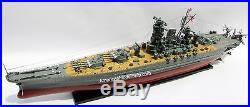

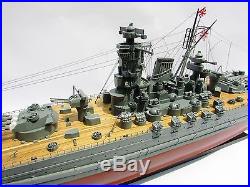
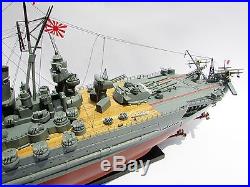
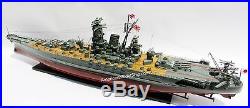
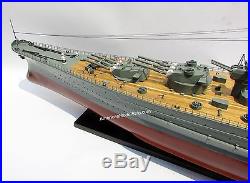
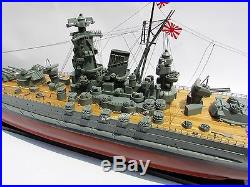
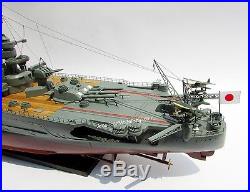
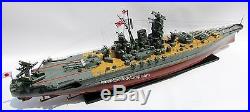
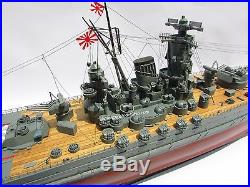

Handmade item The model is 100% scratch built with planks on frame construction method from the drawings. The hull is made of wood and painted. This model is not a kit and ready for display. Model comes with a display base and a brass name plate as shown photos. Specifications: 47L x 7.48W x 13.77H (inch) or 120L x 19W x 35H (cm) Brand new product. Yamato , named after the ancient Japanese Yamato Province, was a battleship of the Imperial Japanese Navy. She and her sister Musashi were the largest, heaviest, and most powerful battleships ever constructed, displacing 72,800 tonnes at full load. The class carried the largest naval artillery ever fitted to any warship – 460 mm (18.1 in) guns which fired 1.36 tonne shells. The Yamato class was built after the Japanese withdrew from the Washington Naval Treaty at the Second London Conference of 1936. The treaty, as extended by the London Naval Treaty of 1930, forbade signatories to build battleships before 1937. Design work on the class began in 1934 and after modifications the design for a 68,000 ton vessel was accepted in March 1937. Yamato was built in intense secrecy at a specially prepared dock to hide her construction at Kure Naval Dockyards beginning on 4 November 1937. She was launched on 8 August 1940 and commissioned on 16 December 1941. Originally, five ships of this class were planned. The third, Shinano, was converted to an aircraft carrier during construction after the defeat at the Battle of Midway. The un-named “Hull Number 111″ was scrapped in 1943 when roughly 30% complete, and “Hull Number 797″, proposed in the 1942 5th Supplementary Program, was never ordered. Plans for a “Super Yamato” class, with 20 inch (508 mm) guns, provisionally designated as “Hull Number 798″ and “Hull Number 799″, were abandoned in 1942. Her 460 mm main guns were selected over 406 mm (16 in) ones because the width of the Panama Canal would make it impractical for the U. Navy to construct a battleship with the same caliber guns without severe design restrictions or inadequate defensive arrangement. To further confuse the intelligence agencies of other countries, Yamato’s main guns were officially named 40.6 cm Special, and civilians were never notified of the true nature of the guns. This worked so well that as late as 1945, the U. Believed the Yamato had 16 inch (406 mm) guns and a 40,823 tonne displacement, comparable to the Iowas. Funding for the Yamato class was also scattered among various projects so the huge costs would not be immediately noticeable. At the Kure Navy Yard, the construction dock was deepened, the gantry crane capacity was increased to 100 tonnes, and part of the dock was roofed over to prevent observation of the work. Many low-level designers and even senior officers were not informed of the true dimensions of the battleship until after the war. Yamato was designed by Keiji Fukuda and followed the trend of unique and generally excellent indigenous Japanese warship designs begun in the 1920s by Fukuda’s predecessor Yuzuru Hiraga. The design of Yamato contained a number of unique features, some of which contributed to the striking appearance of the vessel. To begin with, unlike most of the designs of the 1920s and 1930s, Yamato’s deck was not flush. The undulating line of the main deck forward saved structural weight without reducing hull girder strength. Tests of models in a model basin led to the adoption of a semitransom stern and a bulbous bow, which reduced hull resistance by 8%. The nine 460 mm main battery were the largest ever fielded at sea, a major technological challenge to construct and operate. Their successful implementation in the Yamato class constitutes a major achievement on the part of Japanese naval constructors. The exponentially higher blast effect of the main armament prevented the stowage of boats on deck or the stationing of unshielded personnel in combat. As a result, all anti-aircraft positions (even the smallest) were enclosed in blast shields as designed. Later in their career the anti-aircraft armament of both ships were considerably augmented by open positions of both light and heavy weapons. Presumably AA gun crews would evacuate the weather deck prior to the firing of the main armament. Boats were stowed in below-deck hangars and launched via an unusual traveling crane arrangement mounted on both quarters. The quarter deck aft of Turret 3 was paved with concrete, beneath which a hangar for the stowage of up to seven spotter aircraft was provided for via a wide elevator-like opening in the stern. Contrary to some descriptions the Yamato and Musashi did not have “Pagoda” masts as did previous Japanese battleships, but modern tower bridge structures to house command and fire control facilities. The mainmast, funnel and tower bridge were all unique in design and appearance, differing markedly both from other Japanese battleships and from capital ships of other navies. There is a general “familial” resemblance however between the architecture of the Yamatos and the Hiraga/Fujimoto designed series of cruisers of the 1920s and 30s, particularly the Takao and Mogami classes. The immense beam of these ships made them perhaps the most stable of all battleships. Both ships were reported to be very stable even in heavy seas. However, the increased width of the hull also meant that any loss of stability required a correspondingly greater righting-arm to correct in the event of significant flooding. By comparison the U. Iowa-class fast battleship had one of over 800 m. There was also a smaller auxiliary rudder installed (at frame 219) which was virtually useless. The steam turbine power plant was a relatively low powered design 25 kgf/cm² (2.5 MPa), 325 °C, and as such, their fuel usage rate was very high. This is a primary reason why they were not used during the Solomon Islands campaign and other mid-war operations. In addition, installed horsepower was only 147,948 (110,324kW), limiting her ability to operate with carriers. Arc welding, a relatively new procedure at that time, was used extensively. The lower side-belt armor was used as a strength member of the hull structure. This was done to save weight, an important concern for the designers, despite the lack of treaty limitations. Yamato was the flagship of Admiral Isoroku Yamamoto from 12 February 1942, replacing Nagato. She sailed with Nagato, Mutsu, Hosho, Sendai, nine destroyers, and four auxiliary ships as Yamamoto’s Main Body during the attempted invasion of Midway Atoll in June 1942, but took no active part in the Battle of Midway. From 29 August 1942 to 8 May 1943, she spent all of her time at Truk, being underway for only one day during this entire time. On the way there, she was damaged by a torpedo from the submarine USS Skate, and was not fully repaired until April 1944. During these repairs, additional 127 mm anti-aircraft guns were installed in the place of the 155 mm turrets removed in May, and additional 25 mm anti-aircraft guns were added. She joined the fleet in the Battle of the Philippine Sea in June 1944. In October, she participated in the Battle of Leyte Gulf, during which she first fired her main guns at enemy aircraft and surface ships. During the initial air attack, she received two bomb hits from aircraft which did little damage. However, her sister, Musashi, bore the brunt of the US carrier aircraft attacks and was sunk. Yamato compatriots later sank an escort carrier and some escort vessels at Samar, but Yamato herself was largely absent from the climax of this engagement due to her having turned away from American torpedoes launched from USS Heermann (DD-532). She was attacked in the Inland Sea on 19 March 1945 by carrier aircraft from Task Force 58 as they attacked Kure, but suffered little damage. On 6 April 1945, Yamato was sent on a suicidal mission (operation Ten-Go) against more than 1000 US ships off Okinawa. US carrier-based aircraft sank her before she was close to her target. Her final mission was as part of Operation Ten-Go following the invasion of Okinawa on 1 April 1945. It was a suicide mission (commanded by Admiral Seiichi Ito) to attack the U. Fleet supporting the U. Troops landing on the west of the island; her mission was to beach herself on the coast, in effect becoming an unsinkable gun battery. In addition, the Yamato’s crew was to join the defending Japanese forces on Okinawa after the beaching. On 6 April Yamato and her escorts, the light cruiser Yahagi and eight destroyers, left port at Tokuyama. They were detected by US submarines on the night of 6 April as they exited the Inland Sea southbound. Yamato had no air cover for her final mission, nor did she have many escorts. All of the officers and crew assumed it would be her last voyage. On her final evening, as it was expected U. Carrier planes would attack the next morning, the officers allowed or even ordered the crew to indulge in sake. At about 0830 hours on 7 April 1945, United States fighter planes were launched to pinpoint the Japanese task force. By 1000 hours, Yamato’s radar picked up the U. Planes and a state of battle readiness was commanded. Within seven minutes all doors, hatches and ventilators were closed, and battle stations were fully manned. The super battleship was ready for the coming fury. Yamato fired beehive shells , san-shiki shosan dan? From her main guns against the US planes. Each of these anti-aircraft shells contained thousands of pellets that would be scattered upon explosion – analogous to a massive shotgun round. However, the beehive shells were ineffective against the incoming US planes, and performed little more than pyrotechnic displays. Strafing attacks by the US warplanes would decimate many of the AA gun crews, reducing the battleship’s ability to fend off the attacking US aircraft. Planes from the carrier Hornet joined the strike force from Bennington. Bennington’s VB-82, led by Lieutenant Commander Hugh Wood, was flying at 6,000 m (20,000 ft) altitude in heavy clouds on the bearing to intercept the ships. Although the radar indicated they were very close, the pilots were startled when they realized they were directly above the Japanese task force and within range of anti-aircraft fire. Lieutenant Commander Wood immediately pushed his Helldiver into the clouds and made a sharp left turn, commencing their attack. Wood’s wingman was unable to stay with the formation, leaving Lieutenant (jg) Francis R. Ferry and Lieutenant (jg) Edward A. Sieber to follow Wood into the first strike on the Yamato. The dives began at 20,000 ft directly over the Yamato, bearing from stern to bow. Bombs were released at an altitude of less than about 500 m (1,500 ft). The dives were made as close to a 90-degree angle as possible to avoid most anti-aircraft guns. Each of the three planes released eight 127 mm (5 in) rockets; two armor-piercing bombs and bursts of 20 mm machine gun fire. (jg) Ferry remembers that “at this distance a miss was impossible”. The first two bombs dropped by Lt. Commander Wood hit on the starboard side of the weather deck, knocking out several of the 25 mm machine guns and the high-angle gun turret and ripping a hole in the flying deck. Seconds later came the two bombs from Lt. (jg) Ferry, destroying secondary battery fire control station as they blew through the flying deck, and starting a fire that was never extinguished. This fire continued to spread and is believed to have caused the explosion of the main ammunition magazine as the Yamato capsized some two hours later. Hot on Ferry’s tail was Lt. (jg) Sieber, delivering two bomb hits forward of the island, ripping more holes in the decks in the vicinity of the number three main gun turret. The torpedo plane pilots were ordered to aim for the parts of the Yamato’s hull unprotected by her torpedo defense system: the bow and stern. They were also ordered to attack her on one side only, so that their target would capsize more easily since counter-flooding would become more difficult. Within minutes of the Avengers’ torpedo attacks, the Yamato suffered three torpedo hits to her port side and began listing. Over the next two hours, two more attacks would be launched, pounding the Yamato with torpedoes and bombs. The huge mushroom of fire and smoke exploded almost four miles into the air and the fire was seen by sentries 125 miles away in Kagoshima prefecture on Kyushu, the southernmost of Japan’s four main islands. The end had come for the Yamato, foreshadowing the coming end of the Imperial Japanese Military. Ten aircraft and 12 airmen were lost in the attack on the Yamato. Yamato moments after exploding Yamato moments after exploding Naval gunfire took no part in Yamato’s demise. The wreckage lies in around 300 meters of water and was surveyed in 1985 and 1999. These surveys show the hull to be in two pieces with the break occurring in the area of the second (‘B’) main turret. 2, resulting in the famous pictures of the actual explosion and subsequent smoke column photographed by US aircraft (shown above and recorded as being seen in southern Japan, one hundred miles away). The bow section landed upright, with the stern section remaining keel up. A further large hole was found in the stern section, strongly suggesting that a third magazine explosion occurred, possibly the aft 155 mm gun magazine. Further examples of capital ships being lost due to magazine detonations of this nature during or after battle are the British battlecruisers HMS Queen Mary, Invincible and Indefatigable at the battle of Jutland in 1916, Hood at battle of the Denmark Strait in 1941, USS Arizona at Pearl Harbor in 1941 and HMS Barham in the Eastern Mediterranean in 1941. In 2005, a Yamato museum opened in Kure, Hiroshima. A film based on the Yamato and her crew: Otoko-tachi no Yamato, was made in 2005. It was also prominently featured in the 2004 anime Zipang. The UK television personality Jeremy Clarkson wrote a chapter on the Yamato in his 2004 book I Know You Got Soul, in which he searches through history for machines that transcend mechanical boundaries and almost take on personalities of their own. A starship named U. The item “Battleship YAMATO Japanese Navy Ship Model 47 Built Wooden Model Ship NEW” is in sale since Tuesday, December 27, 2016. This item is in the category “Collectibles\Transportation\Boats & Ships\Military\Models”. The seller is “americanmodelship” and is located in Houston, Texas. This item can be shipped to United States, to Canada, to United Kingdom, to China, to Mexico, to Germany, to Japan, BR, to France, to Australia, RU, DK, RO, SK, BG, CZ, FI, HU, LV, LT, MT, EE, GR, PT, CY, SI, SE, KR, ID, to Taiwan, ZA, TH, to Belgium, to Hong Kong, to Ireland, to Netherlands, PL, to Spain, to Italy, to Austria, IL, to New Zealand, SG, to Switzerland, NO, SA, UA, AE, QA, KW, BH, HR, MY, CL, CO, CR, PA, TT, GT, HN, JM.

